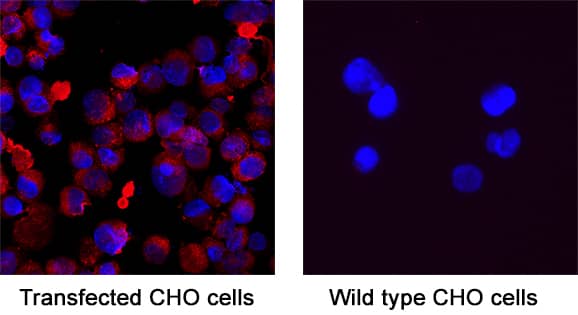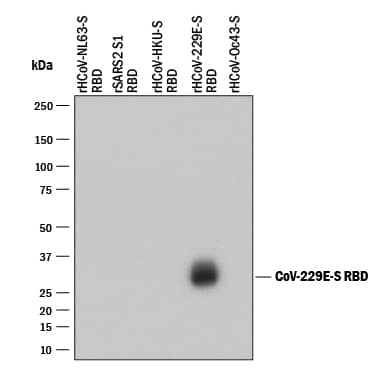HCoV-229E Human Coronavirus Spike RBD Antibody
R&D Systems, part of Bio-Techne | Catalog # MAB10938

Key Product Details
Species Reactivity
HCoV-229E
Applications
Immunocytochemistry, Simple Western, Western Blot
Label
Unconjugated
Antibody Source
Monoclonal Mouse IgG2B Clone # 1045017
Product Specifications
Immunogen
Human embryonic kidney cell HEK293-derived HCoV-229E Spike RBD
Ser292-Asp453
Accession # P15423.1
Ser292-Asp453
Accession # P15423.1
Specificity
Detects Human Coronavirus HCoV-229E in direct ELISAs.
Clonality
Monoclonal
Host
Mouse
Isotype
IgG2B
Scientific Data Images for HCoV-229E Human Coronavirus Spike RBD Antibody
Detection of Spike RBD by Western Blot.
Western blot shows recombinant HCoV-229E-S RBD. PVDF membrane was probed with 1 µg/mL of Mouse Anti-HCoV-HKU1 Spike RBD Monoclonal Antibody (Catalog # MAB10938) followed by HRP-conjugated Anti-Mouse IgG Secondary Antibody (HAF018). A specific band was detected for Spike RBD at approximately 30 kDa (as indicated). This experiment was conducted under reducing conditions and using Western Blot Buffer Group 1.Spike RBD in CHO Chinese hamster ovary cell line transfected with HCoV-229E .
Spike RBD was detected in immersion fixed CHO Chinese hamster ovary cell line transfected with HCoV-229E (positive staining) and CHO Chinese hamster ovary cell line (non-transfected, negative staining) using Mouse Anti-HCoV-HKU1 Spike RBD Monoclonal Antibody (Catalog # MAB10938) at 8 µg/mL for 3 hours at room temperature. Cells were stained using the NorthernLights™ 557-conjugated Anti-Mouse IgG Secondary Antibody (red; NL007) and counterstained with DAPI (blue). Specific staining was localized to cell cytoplasm. Staining was performed using our protocol for Fluorescent ICC Staining of Non-adherent Cells.Detection of SARS-CoV-2 Spike RBD by Simple WesternTM.
Simple Western lane view recombinant HCoV-229E-S RBD, loaded at 0.2 mg/mL. A specific band was detected for Spike RBD at approximately 47 kDa (as indicated) using 20 µg/mL of Mouse Anti-HCoV-229E Human Coronavirus Spike RBD Monoclonal Antibody (Catalog # MAB10938) . This experiment was conducted under reducing conditions and using the 12-230 kDa separation system.Applications for HCoV-229E Human Coronavirus Spike RBD Antibody
Application
Recommended Usage
Immunocytochemistry
8-25 µg/mL
Sample: Immersion fixed CHO Chinese hamster ovary cell line transfected with HCoV-229E
Sample: Immersion fixed CHO Chinese hamster ovary cell line transfected with HCoV-229E
Simple Western
20 µg/mL
Sample: Recombinant HCoV-229E-S RBD
Sample: Recombinant HCoV-229E-S RBD
Western Blot
1 µg/mL
Sample: Recombinant HCoV-229E-S RBD
Sample: Recombinant HCoV-229E-S RBD
Formulation, Preparation, and Storage
Purification
Protein A or G purified from hybridoma culture supernatant
Reconstitution
Reconstitute at 0.5 mg/mL in sterile PBS. For liquid material, refer to CoA for concentration.
Formulation
Lyophilized from a 0.2 μm filtered solution in PBS with Trehalose. *Small pack size (SP) is supplied either lyophilized or as a 0.2 µm filtered solution in PBS.
Shipping
Lyophilized product is shipped at ambient temperature. Liquid small pack size (-SP) is shipped with polar packs. Upon receipt, store immediately at the temperature recommended below.
Stability & Storage
Use a manual defrost freezer and avoid repeated freeze-thaw cycles.
- 12 months from date of receipt, -20 to -70 °C as supplied.
- 1 month, 2 to 8 °C under sterile conditions after reconstitution.
- 6 months, -20 to -70 °C under sterile conditions after reconstitution.
Background: Spike RBD
References
- Hamre, D. and J.J. Procknow (1966) Proc. Soc. Exp. Biol. Med. 121:190.
- Van der Hoek, L. et al. (2004) Nat. Med. 10:368.
- Yeager, C.L. et al. (1992) Nature 357:420.
- Wong, A.H.M. et al. (2017) Nat. Commun. 8:1735.
Long Name
Spike Receptor Binding Domain
Gene Symbol
S
UniProt
Additional Spike RBD Products
Product Documents for HCoV-229E Human Coronavirus Spike RBD Antibody
Product Specific Notices for HCoV-229E Human Coronavirus Spike RBD Antibody
For research use only
